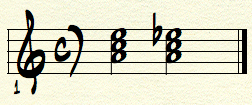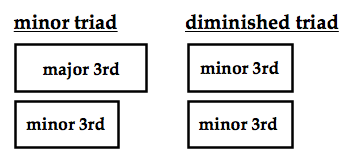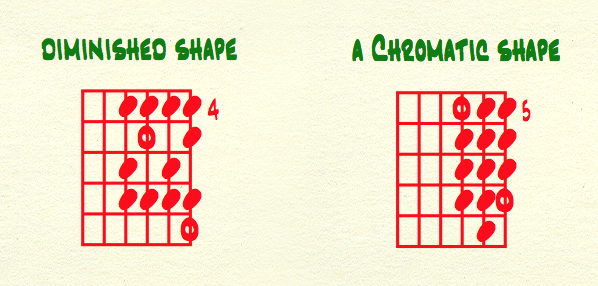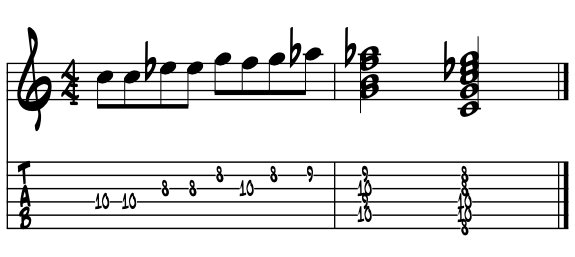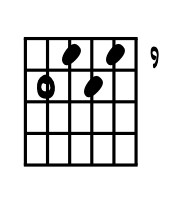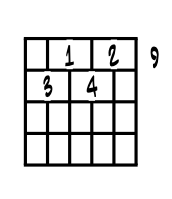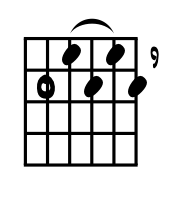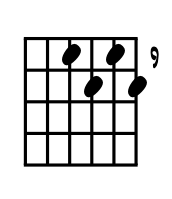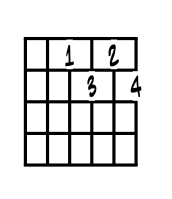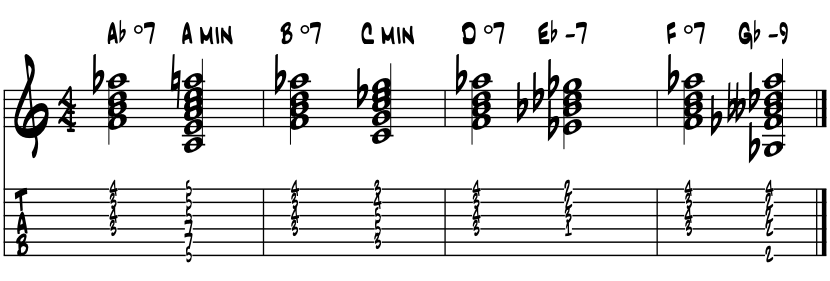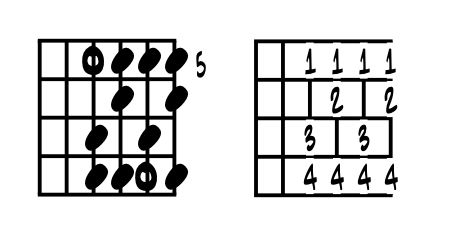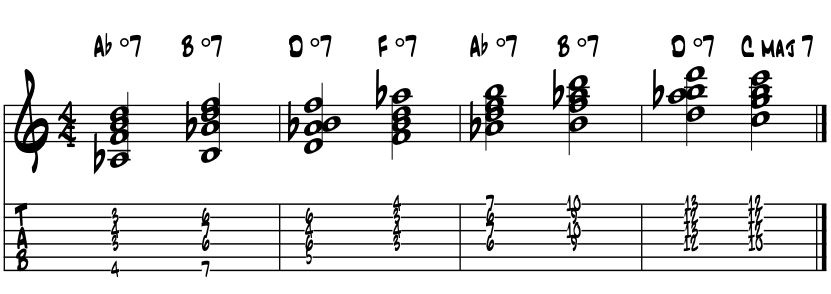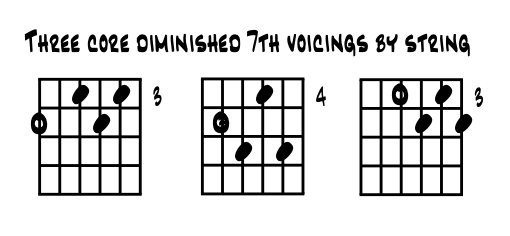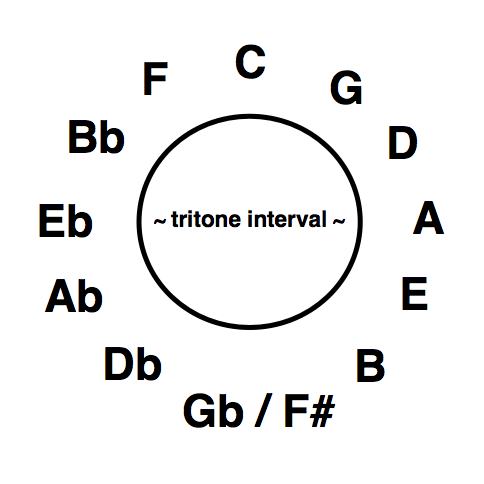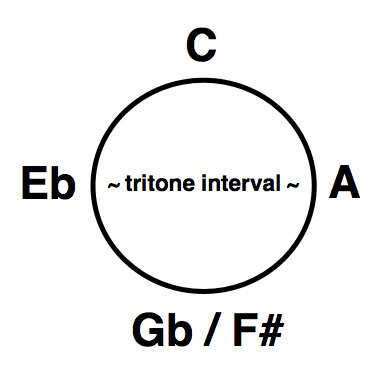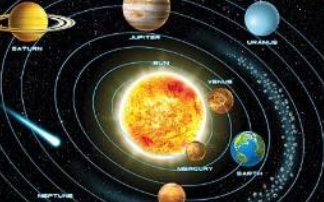Nut in the shell of the diminished colors. If you're brand new to discovering, examining, and understanding the diminished colors and chords then cool, for there's a whole new world of chord colors to explore for mixing into the diatonic realm. For the diminished colors are a symmetrically built component of the common minor / blue 3rd interval, giving it some amazing harmonic wiggle room ( and corresponding melody ideas ) all within the AmerAfroEuroLatin diatonic realm. |
The scale version of this color, the diminished scale, is a rare find through the Americana songbook until we get to the jazz side of the spectrum, where it blossoms many ways. Same mostly with the diminished chord in rock and pop. When it does appear, we hear something very unique, and like its counterbalance, the augmented colors (major 3rd's), they become the 'perfect' chord in that spot, often making a song into a one of a kind, a gem as they say in Nashville. That we can find the diminished color in our original blues, it takes us back from today's modern to an Americana origin taproot. |
Note. That in the day to day making of our musics, on the folk, country, rock, and into the pop side of our musical spectrum, the diminished colors are a bit rare. But going the other way ... towards the bossa, jazz rock fusion and mainstream jazz horizon ? There's just no end to the mixing potentials of these diminished colors; scale, arpeggio, triad, 7th chord and its DNA properties for chord substitution. In some music theory circles, the symmetrical diminished color is the historical hinge point in the evolutions of of 1930's 'swing' into the bebop of the 1940's. Often considered among our most complex styles of jazz, bebop and what came after both compositionally and improvisationally, is in part foundationed on the 'four leading tones' potentials that are built right into the fully diminished 7th chord structure. |
Add a seventh. While in theory we can diatonically generate the three note diminished triad from a few different yet associated parent scales; relative major / natural minor and all their diatonic modes, melodic and harmonic minor and the purely symmetrical whole tone / half tone diminished scale group, this all changes rather dramatically when we look to add a 7th to the triad. And as with chords generally, when we add a 7th to the triad, the new 7th chord opens us into new and often bigger theory vistas to explore the common places it's found in the music. The idea of chord type is one vista. Dominant 7th / V7b9 substitutions for another. With the diminished colors, we get two varieties; the half and fully diminished seventh chords, each with their own unique properties that shapes how and where we find them through our Americana spectrum of styles. Same diminished triad, different 7th. Half or fully diminished 7th chords share the same triad. It is the 7th added that creates the unique shading between these two hues of the minor color. Note their slightly different symbols; the half diminished 7th (circle with line) is a pure diatonic chord, the fully diminished 7th is not diatonic but a symmetrical structure of minor 3rd intervals (circle). |
Diminished triad / a diatonic source. The diatonic source of our diminished triad comes from the pitches of our natural, relative major / minor scale. We locate the root pitch of this triad from the 7th scale degree. In the diminishing process we just make our regular old minor triad a bit more minor by diminishing the 5th by half step. So a minor triad becomes diminished. Compare the building blocks of thirds as we evolve a minor triad into diminished one. Example 1. |
Evolving the minor triad into diminished. Example 1a. |
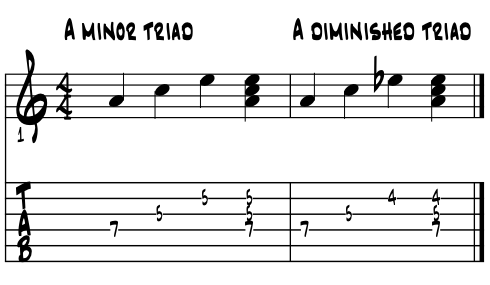 |
So we simply diminish the upper major 3rd of the minor triad by half step to create the diminished triad; two stacked minor 3rd intervals above our chosen root pitch. Next we can locate these two intervals as we evolve our parent scale C major into its arpeggio form and spell out the pitches. Example 1b. |
scale degree |
root (1) |
2 |
3 |
4 |
5 |
6 |
7 |
8 |
scale pitches |
C |
D |
E |
F |
G |
A |
B |
C |
arpeggio degree |
root (1) |
3 |
5 |
7 |
9 |
11 |
13 |
15 |
arpeggio pitches |
C |
E |
G |
B |
D |
F |
A |
C |
arpeggio intervals |
. |
maj 3 |
min 3 |
maj 3 |
min 3 |
min 3 |
maj 3 |
min 3 |
The diminished triad in V7. In the just above chart helps to focus our attention as to just where our two consecutive minor 3rds appear in the diatonic arpeggio to create the diminished triad. Finding B natural in our scale we see it is located on the 7th scale degree, Seven, thus it is the leading tone in C major. We simply spell our triad pitches from there. Example 1c. |
 |
Clearly we might hear and see this diminished triad as part of the vanilla G7 chord; a super essential to all of our styles of Americana musics, thus a consistent style exception to the general absence of the diminished triad colors on the folk end of our Americana style spectrum. |
In this next idea we find a couple of movable G7 voicings to resolve C major. Example 1d. |
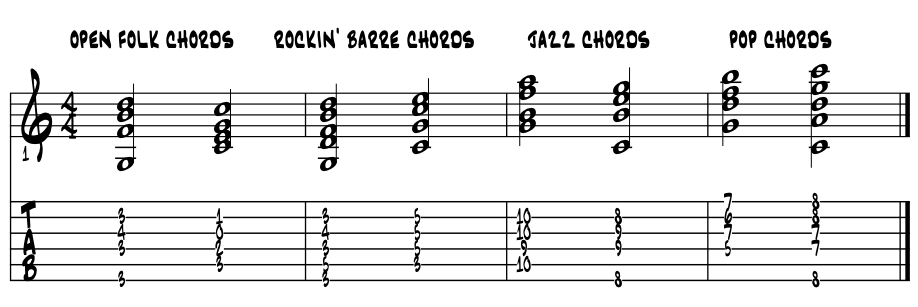 |
As we move up the neck and reshape the chords, we can evolve through the styles by also adding on the color tones as additional pitches above the triads. From this three note, triad basis, we begin the next phase of this discussion by adding the 7th, the color tone that evolves our three note diatonic triads into four note 7th chords, and in doing so opening up a vast new universe of harmonic colors and possibilities. |
Half or fully diminished 7th chord. For many emerging theorists, the distinction between these two colors often creates a bit of a conundrum. Actually, this distinction is often at the top of the 'confusing' list for many of us. There's basically just the two; half or fully diminished 7th chords. And as their name implies, one is simply a bit more diminished than the other; 'half' versus 'full.' |
Sharing the same triad. So these two critters share the same diatonic, diminished triad as generated just above. It is in adding the 7th above the triad that allows their individual magics to unfold. It goes like this. Generating our 7th from the major scale grouping to add to our diminished triad creates the diatonic half diminished. We then need to diminish this 7th by half step, to create a 'fully diminished 7th chord.' Our fully diminished 7th pitch, being non diatonic to our starting key center, creates the needed extra wiggle for the diminished color's inherent magic. |
So we diminish a component in music theory simply by reducing in size the pitch intervals in scales, arpeggios and chords as measured from our chosen root pitch. With diminished, a 'half becomes a full' simply by reducing chord's 7th just a bit wee more. Examine and compare their sounds using the key center C, and building off of Seven. Example 2. |
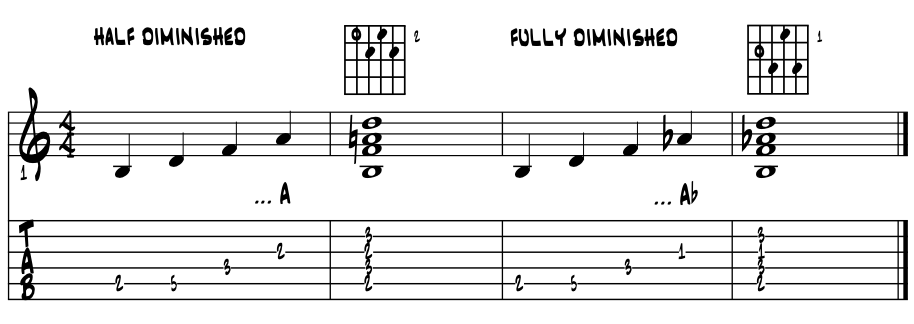 |
Subtle yes but profound in their implications, just the one pitch, the 7th, gets us a wee bit more diminished, its interval as measured from the root further reduced by half step. The organic basis of their theory difference is that the half diminished color has a major third in its construction, as such it is diatonically available from within our natural scale; the relative major and minor group of pitches, i.e., the major scale. Thus it has its own mode; Locrian on Seven. |
Thus deeply organic and imbedded within our ancient core pitches, half diminished can thus seamlessly bolt right up into all of our Americana genres. Please examine its chordal intervals. Example 2a. |
major scale |
C |
D |
E |
F |
G |
A |
B |
C |
arpeggio pitches |
C |
E |
G |
B |
D |
F |
A |
C |
arpeggio intervals |
. |
. |
. |
. |
minor 3 |
minor 3 |
major 3 |
. |
Common diminished chord voicings. For each of these colors there's a couple of core chord shapes to be familiar with. We organize and name them simply by their root pitch on each of the bottom strings three on our guitars. Here are three common voicings for both the half and the fully diminished 7th chords. Example 2b. |
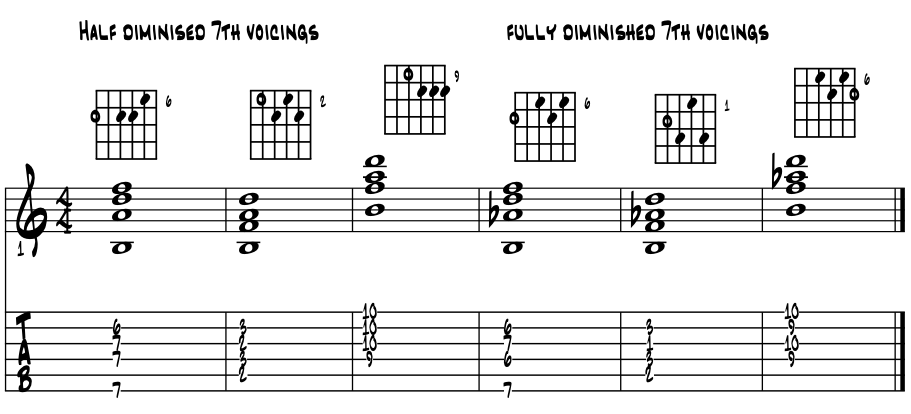 |
Inversions for half and fully diminished 7th. A next step with exploring these chord voicings is to find or create chord shapes that use each successive pitch of their arpeggio as their lowest pitch. Termed a chord 'inversion', 1st, 2nd and 3rd, in doing this we create variety as well as new pathways for voice leading; how each of the 'voice' (notes) in a chord move as we progress from one chord to another in our songs. |
As we'll see in just a bit, the fully diminished 7th color is constructed as a symmetrical shape of the minor 3rd interval, so thanks to the nature of our stringed instruments, the exact same diminished 7th chord shape 'perfectly inverts' its four pitches every three frets while moving up or down the fingerboard. So while the half diminished is very close in pitches, the shape of the voicings change as we move through the inversions up or down the fingerboard. Here are the basic four shapes of the upper four strings. Example 2c. |
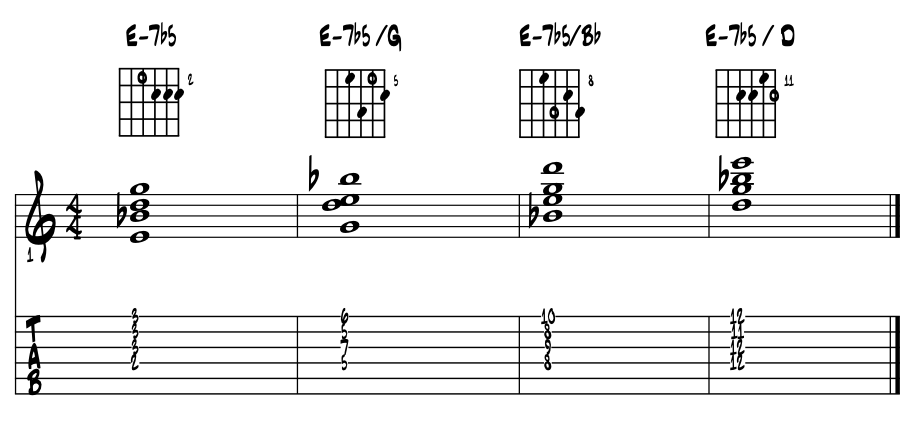 |
Cool? Simply moving one shape up the neck and rearranging the pitches as we go. Mostly a jazz guitar thing? Yep, though knowing this process is helpful when in the hunt for passing chords or the one exact chord in that certain spot to solve a compositional puzzle Here's the basics for half diminished for the 6th and 5th strings. Use the tab to find the shapes. Oh, are there arpeggio shapes for half and fully diminished too? Of course, we have it all here :) Example 2d. |
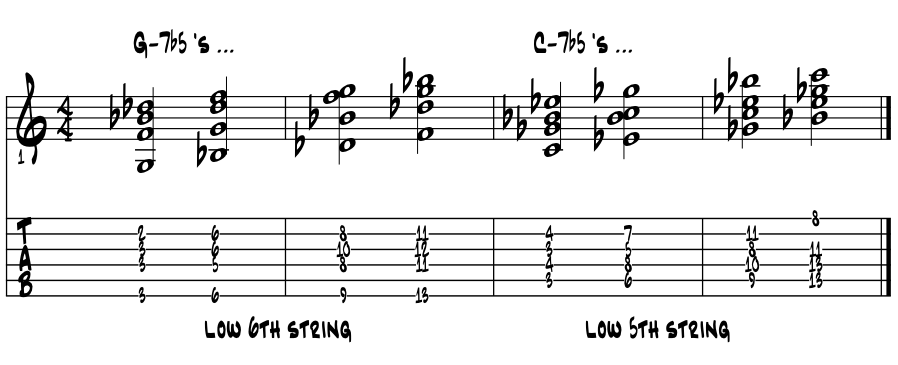 |
Parent scale / half diminished. In this next idea we use the diatonic parent scale for half diminished and simply create a melodic idea over the the half diminished chord and resolve to a tonic major chord. Thinking Locrian mode of C major, we're simply running the pitches of the C major scale from B to B or so :) Example 2b. |
 |
Fits like a glove. Easy to hear how the diatonic Locrian bolts right up to the half diminished 7th chord. Creating a sequence with the pitches helps of course. For sequences just seem to create their own direction and impending resolution. |
Non-diatonic. The fully diminished 7th color is simply not completely diatonic to our major scale group. Is this a problem? Of course not, it's just that as theorists we want to know the source of our musical colors. And as the major scale is the center of most of our local musical Americana universe, we simply want to be as clear on this distinction as we can. Examine the pitches. Ex. 2b. |
major scale |
C |
D |
E |
F |
G |
A |
B |
C |
arpeggio pitches |
C |
E |
G |
B |
D |
F |
Ab |
C |
arpeggio intervals |
. |
. |
. |
. |
minor 3 |
minor 3 |
minor 3 |
. |
The pitch Ab is our non-diatonic tone in relation to our major scale. While we loose our diatonic status here in relation to half diminished, we now gain a symmetrical and consecutive grouping of three minor 3rd intervals. This simple tweak in pitches plays giant in our theory evolutions. For while we loose diatonic status we gain a portal into the whole process of Americana chord substitution, which can be theorized and projected with this interval symmetry. |
Also, this minor third symmetry is one of a handful of our main uniform structures examined in Essentials. Each can play a integral part in our own creative process, as the symmetry of intervals can create a more decidedly 'modern' sound beyond the traditional diatonic realm's alignments of various now age old diatonic balances. Might symmetrical structures in composing aural music be thought of as a 'cubist' compositional approach in visual painting? Sure why not :) |
Diatonic source / fully diminished 7th arpeggio. We can diatonically locate the fully diminished 7th arpeggio and thanks to equal temper tuning its chord, from the harmonic minor grouping of pitches. Generally off the radar for most composers and players until we near the jazzier end of our style spectrum, the harmonic minor flavor goes way back in our music histories and is perhaps most commonly sounded in our Klezmer musics of past and today. Let's quickly source this arpeggio from harmonic minor group before moving on. Please examine the letter name pitches building from a C root pitch. Example 2c. |
|
harmonic minor scale |
C |
D |
Eb |
F |
G |
Ab |
B |
C |
harmonic minor arpeggio |
C |
Eb |
G |
B |
D |
F |
Ab |
C |
dim 7th arpeggio pitches |
. |
. |
. |
B |
D |
F |
Ab |
. |
Cool? Just stacking of minor 3rds really, (B, D, F, Ab) but always good theory to know our diatonic source of each color. |
Parent scale / fully diminished 7th. As done with the half diminished color above, our diatonic source for our fully diminished 7th arpeggio, harmonic minor, becomes one of our parent scale choices for creating melodic ideas over the fully diminished 7th colors. Mostly the same idea as above with the pitches adjusted to create our parent scale harmonic minor resolving to C minor. Example. 2d. |
 |
Well, maybe not so glovelike. Needless to say we're getting further and further away from our most common compositional center of the relative major and minor. In doing so, and sounded here through a digital mix, the pitches become increasingly difficult to manage and to create meaningful melody lines with. Just theory here; an organic, diatonic parent scale choice for the diminished color. And thankfully, leaving the real art to each artist to create. |
Loops / symmetrical scale / fully diminished 7th. A second parent scale for the fully diminished 7th color comes to us through the perfect symmetry of the color's construction. For in stacking just minor 3rds, we get some additional magics to work with. Here we simply divide each minor 3rd into whole step and half step, creating the most common of our 'diminished scales.' Example 2e. |
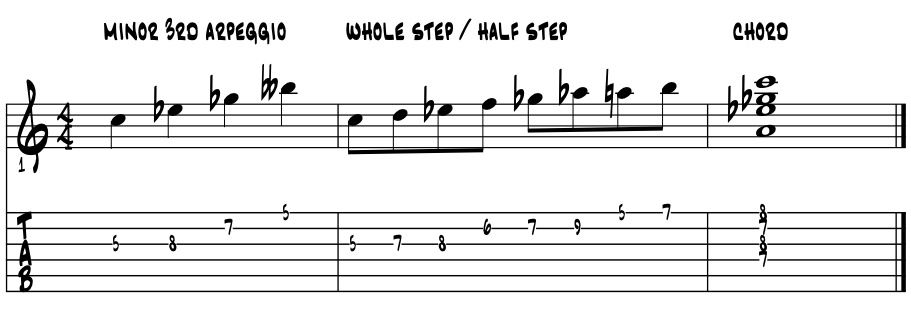 |
Arpeggio, scale and chord. All quite diminished. So depending on the art in your heart, this color might be off to one side, here now front and center to get familiar with and locate on our palettes. |
Quick review. So depending on how you art flows, both of these two diminished colors can become equal partners in working the relative major / minor basis of most all of our Americana musics. For with songs from the 'diatonic 3 and 3' basis, the diminished colors often become a portal between the mixing of major and minor of well crafted compositions all within one key center. Here's a common idea or two for these two colors in our diatonic '3 and 3.' Example 2f. |
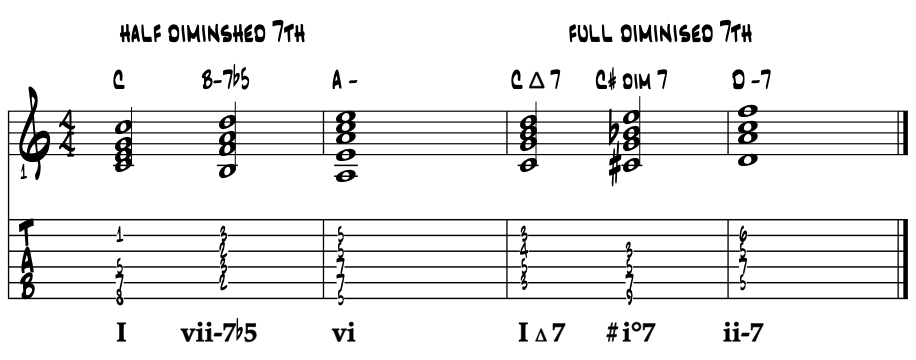 |
What follows. So what follows here is simply a look at the most common ways we'll find and use these two puzzle pieces in our work. While half diminished is diatonic from Seven of the major scale and thus enjoys a wide organic basis all throughout our Americana musics, the fully diminished 7th arpeggio has a 'diatonic' source from harmonic minor group basis, and there's just not a lot of songs written with that group, so we fudge a bit and look to tritone in V7 for pathways to explore. With the blues. While slipping dim 7 chords between diatonic degrees creates an accelerator and the foundation for subbing chords, in the three chord 12 bar blues, we can locate the three unique pitched diminished 7th arpeggios that combine to provide the 12 pitches of the chromatic scale. |
Three for three in a 12 bar blues. Just turns out that each of the three chords in a traditional 12 bar blues; a '1 4 5', brings us one of the three available diminished scales. Talk about theory closure huh ? Thinking from the root in minor 3rd's, in 'C.' Example 2g.
Too cool huh ? That the 12 pitches of the chromatic scale are all include through foundational 12 bar blues of Americana musics. Thinking 'C' blues, know of these scale shapes ? Example 2h. Talk about puzzles ! Thank goodness for bass and drums ! |
|||||||||||||||||||||||||||||||||||||
Diminished between the diatonic pitches. That our diatonic scale is created by five whole steps and two half steps, we've the opportunity to slip in a diminished color into each of these whole steps. Some will accelerate the sense of forward motion, while others create a sense of sort of a temporary pause or hold. Here listed as links, explore each in turn to get a sense of their placement within the diatonic group. |
In truth, using the diminished color to create this sense of renewed energy and accelerated motion is hands down a jazz style thing. For while there's a few spots in complimentary genres, mostly the blues, using the diminished colors to accelerate the sense of motion is a jazz thing. Yet knowledge of a color, its structural theory and what it can do, is truly the crux of how in theory and philosophy a 'modern guitarist' is celebrated in this work. |
Theory empowered to find that perfect note, chord, rhythm whatever to 'solve the puzzle' can help elevate a song to 'gem' status. And gems are often top 10's yes? Self penned "Hey Jay Bell", among Alaska's favorite sound men for the last couple of decades, is a pure stompin' cloggin' pencil dancin' bluegrass cooker' of a pure country tale (yes with a bear too :) that gets all jazzed up simply with a #i dim 7 chord motion going to Two in the opening bars of the 'A' section. Can we find a fully diminished 7th chord to fit on a mando ... :) Surely. I've know heard them on banjos for sure. So yet more shedding for those so inclined to play 'through the changes' and knowledge is power yes? Si Amigo, and back to the shed we go to open up a new can of theory. |
Darkness before dawn. If 'in theory', we can assign actual endpoints to our diatonic spectrum of musical colors, placing the diminished group of pitches on the end that creates the 'darkest before the dawn' emotional moods of our music would probably not raise a eyebrow of even the staunchest of our didactics. |
As a chord, the fully diminished 7th simply bristles with aural tension that has little of the organic or diatonic sense of resolution or at peace when sounded on its own. For there is no pitch in this chord that does not contribute to this sense of bristle, yet each of its pitches can equally become a leading tone to point us back to the tonality of a key center. That the diminished colors contain this dual quality of moodiest of tensions that also create pathways to the joyest of resolving light is the basis of the theory discussions which follow. |
Defining 'diminished.' As the word's standard meaning implies, when we 'diminish' something, we're simply reducing its stature. In our music theory same thing, we are simply reducing the stature or diminishing the size, of a musical interval. There's a bit of an evolution here as we diminish an interval, depending on our starting point. And while there's a theorist's way to fully account for every nook and cranny, shape and size of all of our intervals, in our discussion here we've initially just a select few interval labels that we must rote learn. For we're simply looking to internalize and label the aural and theory properties of the diminished 7th color's basic components; a scale, an arpeggio, a triad and a 7th chord. Examine the following idea from C. Example 3. |
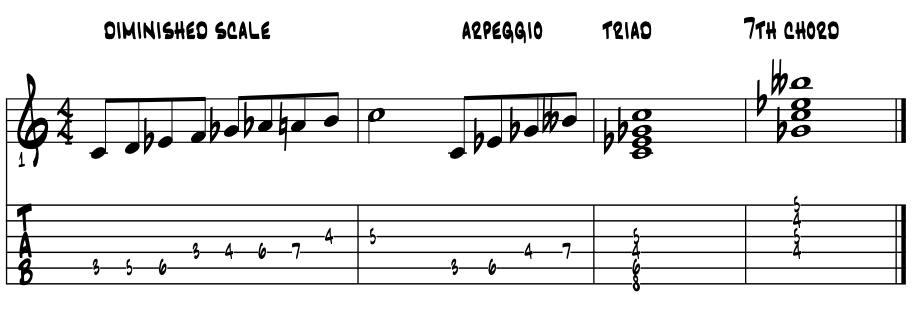 |
Familiar sounds? Cool. No? Check it out in context in this next idea. Extracting from the 1967 radio pop hit "Spooky" by the Classics IV. Example 3a. |
|
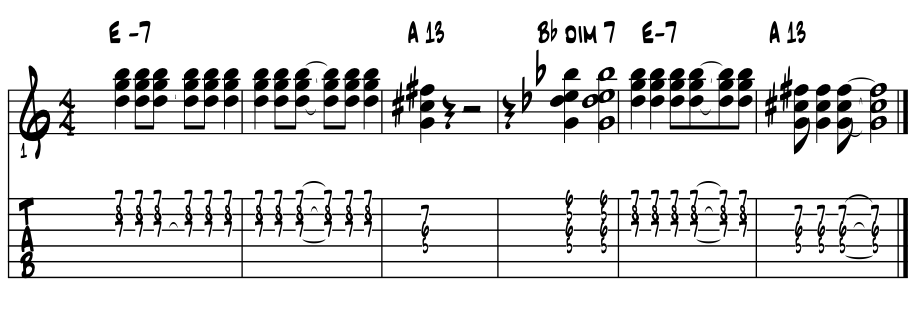 |
Sorry about the notation playback, get the right rhythms right off the recording, the chord voicings should be cool, their pitches are just the top three notes of the chords, partial chords with no root pitch, leaving a big space for the bass player to lay the groove in. Younger players coming up should probably learn this standard pop tune. Easy tune, octave leap in melody, cool pocket, easy bass line, everyone knows it in the room so it usually fills the dance floor on Halloween gigs. Also, there's been some remakes with super smokin' way creative modern guitar solos over the two chord vamp. |
Fully diminished 7th chord intervals. The core interval used to construct the fully diminished 7th colors is exclusively the minor 3rd interval. As we stack these one atop another the diminished colors evolve. The first minor 3rd above a root pitch gives us the essential minor / blue 3rd. The second stacked minor 3rd creates a diminished 5th which completes the diminished triad. The next minor 3rd atop creates a diminished 7th interval as measured from our root pitch and completes the fully diminished 7th chord. Example 4. |
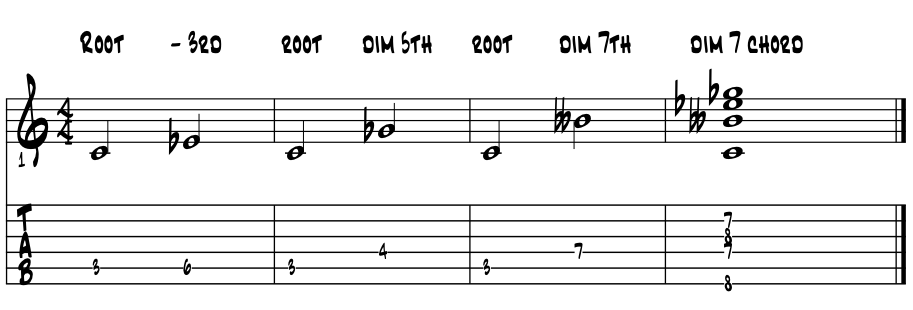 |
So we're starting to get at that 'bristling sound' yes? So one minor 3rd interval is a blue note. Two minor 3rd intervals stacked is a diminished 5th interval and three creates the diminished 7th interval. Add them all up into a fully diminished 7th chord. And two minor 3rd's stacked becomes a diminished 5th, which is also known as the tritone? The 'musica diablo?' The juice within V7? Super dominant chord catalyst to all points beyond? That unmistakable blue honk and ultimate deep blues rub? Yep, that's the tritone. Quite a lot from one pitch :) |
|
Diminished 5th / 'three tone' interval. Another way to find our diminished 5th is by just whole steps up from our root pitch. In doing so we'll need 'three whole tones.' As in a tritone? Exactly, 'tri' = three and 'a tone' + a whole step. Example 3. |
 |
Recognize the sound? Pretty character and unique. And cool with the different interval pitch spellings between bars 3 and 4 above? 'F# = Gb ?' That these two notes are said to be enharmonic equivalents? And how about the lick in the last bar? The tritone interval centers the Euro emergency siren, telling us needed help is coming. |
Tritone a la J.S. Bach. This next idea is a classic tritone sort of 'question.' Lifted from the original keyboard monster himself JS Bach of the Baroque era, clearly we can hear the creation of a tritone's nature to create a sense of musical question ... a sort of curiosity ... 'listen up' for there's some coolness to follow :) Example 3a. |
|
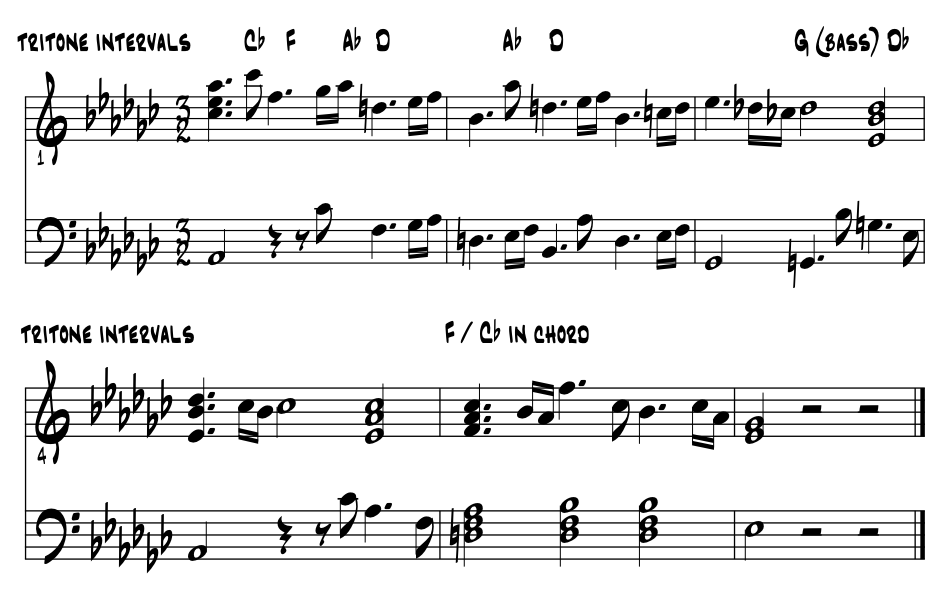 |
As aurally clear as clear ever gets yes? This tritone sound is the basis of diminished color. Rote learn it here if need be and you'll have it forever. |
J.S. Bach. Those of us impassioned about the theory of our Americana harmony should look into this cat. For there's a couple of tons of musical invention that exhausts our equal tempered resource with an aural clarity that simply stuns again and again all throughout his musics. If there's one artist of the European contribution to our Americana musics that covered the theoretical whole tamale in his vast output of creative musical art, JS is this cat. |
|
Fully diminished 7th / 'double' tritone. In the fully diminished 7th chord, we'll end up with two pairs of tritones, a 'double tritone' if you will. This pairing within a single chord voicing is what creates the diminished chord's one-of-a-kind aural 'bristle.' It also energizes its potential for its multiple resolving qualities. Building a fully diminished 7th chord from the root pitch C. Ex. 4. |
 |
So fully diminished 7th has two pairs of tritones. Well it turns out that this four note chord sits right atop the dominant pitch of any key center and provides some wonderful opportunities for artistic, musical, technical and spiritual advancement. Jazz artists in the house? |
Fully diminished double tritone / V7b9 chords. Theorywise we begin a next level of our diminished harmony evolutions for in one swift, bold move we can double the leading tone possibilities discussed with the tritone bearing V7 chord simply by adding the flat Nine pitch. Here thinking in the key center of C major, examine the pitches of its dominant chord G7b9 and its two pairs of tritone pitches. Example 5. |
arpeggio degree |
1 |
3 |
5 |
7 |
9 |
11 |
13 |
15 |
G7b9 |
G |
B |
D |
F |
Ab |
. |
. |
. |
1st tritone interval |
. |
B |
. |
F |
. |
. |
. |
. |
| 2nd tritone interval | . |
. |
D |
. |
Ab |
. |
. |
. |
 |
Two pairs of tritones in one chord. And it sits right atop the dominant pitch of any key center and provides some wonderful opportunities for artistic, musical, technical and spiritual advancement. Jazz artists in the house? |
Notice that one pair of tritones are the 3rd and 7th of the chord? Might these be flipped upside down to create the the 3rd and 7th of a chord with a different root pitch? And if so, can the 'D' and 'Ab' tritone be the 3rd and 7th of a differently rooted chord? And flipped also? In mathematics, if A and B are equal, and B and C are equal, is C then equal to A? :) |
Where in the music. The V7b9 is mainly a jazz color. On occasion we hear it in the blues and pop music. And within this library, b9 is probably more often used in a minor key, as the b9 pitch is diatonic to the natural minor grouping of pitches, thus its effect can be said to be muted or softened in contrast to a major key. Examine the pitches of C natural minor / G7b9. Example 5a. |
C natural minor |
C |
D |
Eb |
F |
G |
Ab |
Bb |
C |
G7b9 pitches |
G |
B |
D |
F |
Ab |
. |
. |
. |
Major or minor. So the V7b9 color works as a cadential chord in both in the major and minor tonalities? Yes it sure can. While flat Nine is diatonic in the harmonic minor grouping of pitches, we have to borrow the pitch to create the chord in the major key. Is there any concern with this? Nope. Welcome to the world of the altered dominant chords and the borrowing of any pitch any time when necessary to express the art of the heart. |
So we borrow pitches all the time in creating the American sounds? Yep. For instance, anytime there's a blue hue in a non blues based tune, chances are it's non-diatonic and borrowed. The idea of diatonic exclusivity simply provides an essential perspective for we theorists who like to know the organic source of all things. Thus empowered, our potential source for new ideas nicely expands as even hearing a wisp of music from any source, that we can theoretically identify and perhaps better recall or write down, might become another spark for new art and expression from our heart. |
Deserted island flat nine shape. If I had to be on a deserted island with just a trusty six string with flat wounds, and only could have one b9 chord shape, it just might be this one. Surely it is the first one I learned when I finally needed one. Ted Greene might have quipped, 'quite a solid little chunk of harmony.' It's just one of those movable chord voicings that works like every time, in a major or minor tonality, jazz or blues etc. Ex. 5b. |
|
fixx with audio
|
Know this chord shape? Cool. Oddly enough we call this critter an incomplete dominant 7th chord. It's incomplete in that it has no fifth in its voicing. Unusual? No. Happens all the time in lots of our guitar chord voicings when we expand our pitches on past our triads and into the color tones. Remember, it is the 3rd and 7th that determine chord quality thus a 'chunks' function. |
The root pitch basses the chord so the 5th can be omitted when needed. Bass player on the gig? Well then maybe the root pitch is not quite so necessary, leaving a spot for the 5th to be included? Just might be the case :) Do examine the four pitches included in the V7b9 shape just above. In C major, thinking from the dominant, Five. Example 5c. |
arpeggio degrees |
1 |
3 |
5 |
7 |
9 |
11 |
13 |
15 |
V7 arpeggio pitches |
G |
B |
D |
F |
A |
C |
E |
G |
V 7b9 pitches |
G |
B |
? |
F |
Ab |
. |
. |
. |
No 5th ... Oh well, no 5th in the voicing. When we do add a perfect 5th interval into this V7b9 chord's pitches, and that's next, the theory and consequently all of its artistic potential in all things dominant, i.e., V, V7, V7b9 / #9 / b5 / #11 / 13 / b13 / sus 4 / and all of their mix and match combinations, substitutions and manifestations, all can advance dramatically via the symmetrical nature of the diminished 7th color. |
Adding the in 5th. Please examine the following pitches as we add in the perfect 5th. Example 5d. |
arpeggio degrees |
1 |
3 |
5 |
7 |
9 |
11 |
13 |
15 |
G7 arpeggio pitches |
G |
B |
D |
F |
A |
C |
E |
G |
G 7b9 pitches |
G |
B |
D |
F |
Ab |
. |
. |
. |
Quick review / easy do. Now with the addition of the 5th we create a symmetrical arpeggio within our G7b9 chord whose 3rd, 5th, 7th and b9 pitches are all a minor third apart. Back to where we started? Yep,a fully diminished 7th arpeggio. Symmetrical; only one build interval, all intervals are the same, thus symmetrical :) Four pitches by minor third interval we term a fully diminished 7th chord. Please examine the pitches and their evolution into chord shapes. Example 5e. |
G7b9 pitches |
G |
B |
D |
F |
Ab |
minor 3rds |
. |
B |
D |
F |
Ab |
|
Fully diminished 7th chord / a circle in the chord symbol. So it turns out that in the upper part of the G7b9 chord we have a fully diminished 7th chord. Once we're cool with jettisoning the root pitch G, and we can often leave that to the bass player, the perfectly symmetrical diminished color is capable of many lovely hues of nuance and shading by filtering its organic properties through our various musical filters. Filters such as; softening back into V7, pairing with Two chords, ascending or descending motions by whole step / half step / minor 3rd, sequencing, revoice the tritones with appropriate key wise color tones etc. |
Please examine the pitches and sound of the V7b9 in action with an eventual resolution to a tonic major chord. Do note the simple circle symbol designating a diminished triad. Example 5f. |
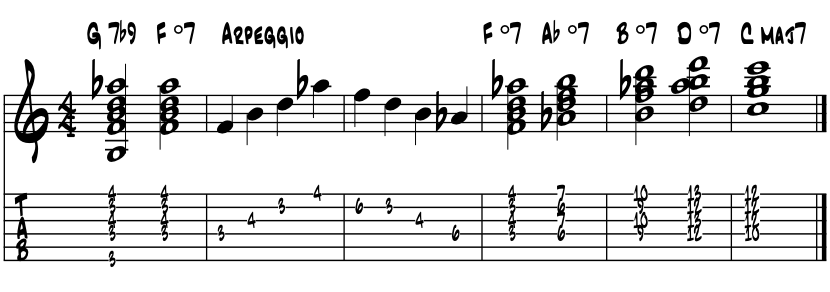 |
Run out of frets? This last idea is a fairly common diminished chord run for guitar. Simply moving the one shape up in minor thirds. Which incidently can go equally up or down yes? And a minor 3rd is equal to a whole step + a half step so we've some options from within also. |
Multiple leading tones ~ 'double tritones.' Way back in this discussion we determined that an organic source of the diminished triad is from the major scale and that we build the diminished triad on its 7th scale degree. Seven of course being the leading tone to resolution and a resting point in the music. And since the diminished color is perfectly symmetrical, might each of its pitches be leading tones, the 7th scale degree, to their appropriate key centers? |
| This is indeed the theory 'case' with fully diminished 7th. For it has the double tritone magic, two sets of tritone intervals, thus our multiple leading tones :) Please examine these possibilities in the following idea; four appropriate major keys followed by their four parallel minor keys. Major keys first. Example 5g. |
diminished 7th arpeggio pitches as leading tones |
Ab (G#) |
B |
D |
F |
resolves up to |
A maj |
C maj |
Eb maj |
Gb maj |
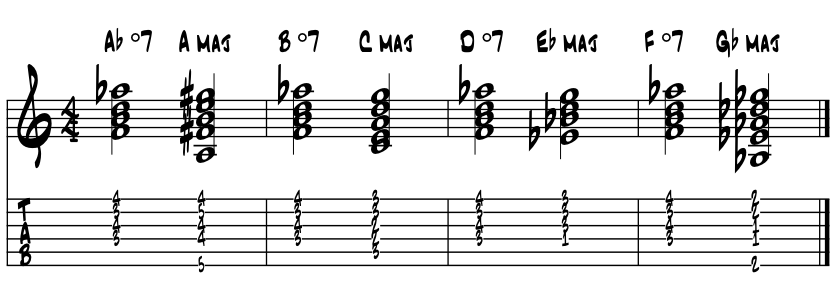 |
diminished 7th arpeggio pitches as leading tones |
Ab (G#) |
B |
D |
F |
resolves up to |
A min |
C min |
Eb min |
Gb min |
Hear how seamlessly the diminished resolves in the minor tonality? Also, sense the softening of the resolving chords as we add the 7th and 9th colortones? It's almost as if the emotion / music style evolves right before our eyes. So really no surprise that our organic, diatonic source for the fully diminished 7th color is from the harmonic minor group; simply a vanilla natural minor grouping with an added leading tone. |
Relative and parallel keys. So aren't those key centers in the last idea also the relative minor of one another? That A minor and C major, Eb minor and G major, parallel key A major to Gb (F#) minor etc., are all these centers relatable to one another through these diminished theory permutations? |
They sure are. So these '4 way' resolutions can work beautifully with one another. In composing music, writers are oftentimes using a 'pivot' chord to get them from one key center to another. The fully diminished 7th chord, with its symmetry inherent tensions, is often just such a chord. So along this line of thought, in this next idea we use the same shape and stay in one spot, simply change the root pitch of each chord and resolve to the four, relative minor key centers. Example 5h. |
diminished arpeggio pitches as leading tones |
Ab (G#) |
B |
D |
F |
resolves up to |
A min |
C min |
Eb min |
Gb min |
 |
Resolves like butter! Sorry :) Regardless, this is what the theory can do for us. Create new ways to understand the relationships between the pitches, key centers and such in composing our music, finding chord substitutions, discovering new ways to cover old ground. Tis' all good. |
Quick review ~ one chord four names. So if we follow the rule that 'if we think from the root we'll never get lost' then chances are we won't. Yet, the diminished 7th colors have a bit more trickery in their naming. Why? Well in theory, the perfect symmetry of their interval construction creates just three unique loops of four pitches that cover all of our 12 possible root pitches. These can become a shorthand way for labeling as the diminished theory evolves into chord substitution and their resolutions. for often times if the theory is 'close enough', artists come along and make these sorts of resolutions work just fine. Please examine the pitches of our three fully diminished 7th chords. The three perfectly closed loops of pitches. Example 5i. |
diminished 7th arpeggio |
. |
up min 3rd |
up a -3rd |
up a min 3rd |
up a min 3rd to perfect closure |
C |
C |
Eb |
Gb |
A |
C |
Db |
Db |
Fb (E) |
G |
Bb |
Db |
D |
D |
F |
Ab |
B |
D |
Eb |
Eb |
Gb |
A |
C |
Eb |
So by the time we get to Eb, we're back to the same pitches as with the C diminished 7th arpeggio. While there's a few ways to look at this, thinking from the root of whatever we have in front of us is a sure way to keep it all straight. Cats probably end up applying their own way of understanding this theory based on how they first learned it. Here it is presented as a sort of 'just so ya know' quick review to help keep things straight. |
Melodic resolutions. Melodically, advancing jazz leaning guitar players might run each of the five diatonic melody shapes through this theory; one shape / one position, four parallel key centers of diatonic major, parallel and relative minor, using their common diminished scale group or chord voicing. Here's the scale shape, sound and a suggested fingering for the fully diminished 7th color in 5th position. Example 5j. |
pitches |
fingering |
 |
So the idea is that with these 'groups of pitches', we simply try create a melodic idea from one group and move to the next. So in this case some diminished tension followed by its release into an idea from the major scale group of pitches. Here in 5th position thinking C7b9 into F major. Example 5k. |
 |
The shedding here is to simply run a similar diminished color idea into the four key centers related to F major so; F, Ab, B and D, and stay roughly in a localized position, so for this exercise, around the 5th fret or so. Jazz players dig this 'local' as oftentimes the tempos are brighter and they play through the changes in songs that often modulate, meaning changing from one key center into another. Resolutions to multiple key centers in localized positions is one goal. Eventually this probably becomes more chromatic . |
V7b9 resolutions. So the basic idea is that we've three fully diminished 7th that are interchangeable to sit atop of the 12 V7b9 chords that resolve to each of the relative major, minor and parallel key centers. A ton of shedding for those so inclined, there's the basic five positions for finding the various chords also. In this next chart we simply group resolutions for each of the three diminished 7th scales. Example 5l. |
diminished 7th within V7b9 |
root of key center resolutions |
C dim / Ab7b9, B7b9, D7b9, F7b9 |
Db, E, G, Bb |
Db (A#) dim / A7b9, C7b9, Eb7b9, F#7b9 |
D, F, Ab, B |
D dim / Bb7b9, Db7b9, E7b9, G7b9 |
Db, E, G, Bb |
Eb dim (C) ... and back to where we started |
~ |
Keeping track of the enharmonic equivalents of this theory mayhem is well, your responsibility. For truth be told, most of the songs we play live on the top half of the 'C' centered cycle of 5th's. Decide what you need and do the shedding in a way so it sticks and is usable. Those that will venture down to the end of the evolution of our Americana harmony path; where all of the chords become some sort of V7 chord type and the melodic lines lean towards the 'chromatic fuzz', will in shedding the above resolutions have laid the groundwork, both intellectual and chops' wise on their ax, to conquer the whole of the Americana tamale through the organic evolutions of the theory as encapsulated by Coltrane. |
Leaps of minor thirds. So, our diminished minor 3rd symmetry allows for all of our diminished chord shapes to be 'theory' moved up or down every three frets, in minor thirds, and still retain the same core pitches, they just trade voices or places in the chord. Please examine the letter name pitches and sounds of the Ab, B, D and F fully diminished 7th chords. Example 6. |
leaping in minor 3rds |
. |
up min 3rd |
up a -3rd |
up a min 3rd |
soprano / diminished 7th |
F |
Ab |
B |
D |
| alto / diminished 5th | D |
F |
Ab |
B |
| tenor / minor 3rd | B |
D |
F |
Ab |
| bass / root | Ab |
B |
D |
F |
Three core diminished shapes. This last idea uses our three core diminished chord shapes or voicings. These three are the starting points for evolving the artistic nuance described just above. By simply having one solid shape for each of the three lower bass strings, we can cover the entire range of the neck rather quickly when needed. Here are the three movable shapes. These are the same three shapes from earlier in this discussion. Example 6a. |
|
OK with these shapes? See the similarity between the first and third voicings just above? Our bass note has simply been moved to the top string while retaining the middle voices. Play through the following chords that use these three shapes in order as a #1dim 7 between One and Two. Example 6b. |
Triangle is major as in G major 7? Yep. Feel a bit of the acceleration in the motion between One and Two with the diminished in between? It's in there somewhere :) |
Fully diminished 7th / where in the music? So diminished chords are mostly found in the jazz styles, we'll see them all the time either written in or added as a substitute chord. Common spots; as a passing diminished chord between diatonic pitches built on #i, #ii and #iv. Replacing the diatonic half diminished on vii. Delaying the resolution to a tonic One chord by using a fully diminished 7th chord with the same root pitch. And as part of the b9 in V7b9? Very common in indeed. |
Further, again the tritone interval is in the metal musical style for sure. Once in a while in pop and rock. In the blues, in more modern times it's not so apparent. In old time blues we oftentimes here it as a common tone tonic chord. In jazzed up blues songs, the fully diminished 7th chord slipped in as a sharp Four chord in bar six of a regular 12 bar blues which follows right here. |
A key diminished chord built on sharp Four. This penultimate entry in covering our sharp Four position within the local chromatic universe is a rather common event in the blues when jazz players get a hold of the 12 bar form. Turns out in the 6th bar the harmony sort of just begs to go to the #iv dim 7 chord. Really? Every time? No, but often enough with jazz players. Just yet another way to accelerate the sense of forward motion while getting a wee bit more mileage out of the thing. Here's the basic changes, thinking C blues. Example 7. |
Taking it out. This next idea for locating a fully diminished 7th chord on sharp Four is quite common in certain circles, it's one of the "arrangements while you wait" type endings that players often will improvise together. It's cool in that we use the tonic pitch as a common tone to link all of the chords together in the descending bass line and progression as we take it out. Thinking F major. Example 7. |
Nice series of chords to play a single line through yes? |
Wheel of tritones / cycle of fifths. Since the tritone interval plays a nice role in the diminished colors, let's chart out the intervals a bit via the cycle of fifth's. For it turns out that the tritone interval enjoys a rather distinctive status on our wheel of pitches. It's curious how this shakes loose but it is what it is. Please examine the location of our tritone intervals on our 12 pitch keyclock. Example 8. |
|
|
||||||||||||||||||||||||||||||||||||
Really? Directly across the clock face? We can locate any pitch's tritone interval by locating the pitch directly across the circle? That is indeed the case mon ami. Crazy huh but very handy :) So knowing this, check this out. Example 8a. |
|
WOW ! Now the compass points show us four key centers, each of which is the major / relative minor tonic of each other. This visualization of the major / minor key centers / tritone from within the cycle of fifth's is new for me. I just discovered this :) Do print and tack these two up for reference if so empowered. |
So where is the tritone in our music. Well anytime we're grooving on anything with a hint of the blues, chances are there's a tritone interval in the neighborhood. So in thinking of the Americana sounds, in a word, everywhere. Well, probably not in children's songs of course, unless they're spooky Halloween tunes. In folk, never ( did I just say never that ... ) in the melody but always of course in any standard type of V7 / G7 / D7 chord etc. The blues influence in any of the rock styles of course needs the tritone pitch / interval. |
The metalists love the tritone interval. It's all over their music and used to dramatic effect. In pop, again any V7 chord is going to have the tritone within. Rare in pop melodies, although one of America's favorite melodies from 1957 "Maria" is classic tritone color. For jazz and beyond, like everything else we jazz theorists can conjure, the tritone is a super catalyst for coolness, a building block to new horizons where it loses its often sad and demonic edge and becomes a key step in the stairway to the bright musical stars and beyond. |
|
Tritone / where in history. Well history has not been overly kind to our tritone. Known at one point as the "Diablo de Musica", the big tritone players in those days probably had a bit of a rough go of it. Of course even early on, when encapsulated within within the V7 chord, the tritone has always been cool. Once the blues took hold, the tritone found a home of its own and even as a melody note, has been a cherished member of the whole of our Americana family. |
|
When the jazz harmony started to evolve in the later 30's toward bebop with cats like guitarist Charlie Christian working the magic, the diminished chord color and its organic 'double tritone' opened up a new way to look at things. As things got hipper, V7b9 created a new way 'out' in jazz speak. Within twenty five years or so of Christian and his bandmate's work, John Coltrane wrote and released his song "Giant Steps", a composition which even today sits as the crown jewel atop the theory / shedding challenges that Mr. Christian helped initiate and that Mr. Coltrane developed and conquered. |
|
Softening the diminished color / part one. In this penultimate entry for our various diminished colors, there's a way to 'soften up' the bristleyness that the diminished intervals bring. Turns out that with the fully symmetrical minor 3rd's of the diminished 7th chord, we can lower any one of the four pitches and evolve a vanilla V7 chord. So four pitches in the diminished 7th chord become the root pitches of four different dominant 7th chords. Examine the pitches. Example 9. |
diminished 7th / minor 3rd's |
Ab |
B |
D |
F |
chord |
root |
3rd |
5th |
7th |
G 7 |
G |
B |
D |
F |
Bb 7 |
Bb |
D |
F |
Ab |
Db 7 |
D |
F |
Ab |
B (Cb) |
E 7 |
E |
Ab (G#) |
B |
D |
Wow, now that's interesting for those so inclined. What do these become? These four chords become the basis of V7, dominant chord substitutions. In C major, G7 is Five, The Bb7 is bVII and a blues / Mixolydian flavor and often the basis for various two chord vamps. The Db7 is the essential tritone substitute chord, a staple for many jazz players. While the E7 is usually a Five chord to C major's relative, A minor. So a bit of a surprise when used in cadential motions towards C major. Explore the links forward as your curiosity demands. |
Softening the diminished color / part two. In this last entry for our various diminished colors, there's another way to 'soften up' the bristleyness that the diminished intervals bring. Turns out that with the fully symmetrical minor 3rd's of the diminished 7th chord, we can raise any one of the four pitches and evolve a half diminished 7th chord that is the diatonic Two chord of each of the vanilla V7 chords from the last idea. So four pitches in the diminished 7th chord become the root pitches of four different half diminished 7th chords. Please examine the pitches. Example 9. |
diminished 7th / minor 3rd's |
Ab |
B |
D |
F |
chord |
root |
3rd |
5th |
7th |
B -7b5 / E7 |
A |
B |
D |
F |
D -7b5 / G7 |
C |
D |
F |
Ab |
F -7b5 / Bb7 |
D#(Eb) |
F |
Ab |
B (Cb) |
Ab -7b5 / Db |
F#(Gb) |
Ab |
B (Cb) |
D (Ebb) |
So as with four V7 chords, we can now pair up each one up with its Two chord. What do it mean? Well mostly about chord substitution and finding new ways to get to usual places. We can also trace things back towards their diatonic basis opening up additional modal possibilities. Lastly, we've similar ideas for the melodic minor grouping of pitches, using the diminished principles of symmetrical resolutions but with a softer hue. And the melodic minor group does = Lydian flat 7 yes ? |
C melodic minor |
C |
D |
Eb |
F |
G |
A |
B |
C |
F Lydian b7 |
F |
G |
A |
B |
C |
D |
Eb |
F |
Tritone review. Perhaps needless to say the tritone has come quite a ways since its days as "the diablo of music." A core component in Americana blues, which of course is at the root of all things American music, the tritone and its related activities plays an essential role in anything blues and beyond. And while we'll find the dominant chord's inner tritone V7 sounds in folk music, most any other use of its sound is simply not a part of the original folk tradition. |
Our tritone comes in two basic varieties. As a single note interval measured from another or as a two pitch, pre-made tritone, that we slip into existing structures. Our single pitch, octave splitter is the crucial pitch to evolve the blues scale from its minor pentatonic core. While the two pitch tritone evolves the major pentatonic grouping of pitches into the diatonic major / relative minor scales. |
In our harmony, the tritone color creates the key aural tension that makes our dominant Five seven chord a dominant V7 chord. We'll find this basic chord generally within all of our American musical styles. From V7 forward, at least within the jazz language, artists have added the tritone's symmetrical theory properties to their palette of techniques, thus continuing their search for the myriad of nuanced ways to create the tension and its release of their art. |
Diminished colors / Americana harmony evolutions. A central thread through this Essentials text is the idea of an evolution of Americana harmony that runs through our spectrum of musical styles. The idea hear is that by understanding how our harmony is sourced and used to create music within a style or genre, we can see it's numerical evolutions as we move from the mostly three chord folk styles and blues styles into the 'diatonic 3 and 3' of rock, pop and country to arrive at the often 'chock full of changes' jazz approach to Americana harmony. With such a basis, we can become more of a 'modern guitarist' in our own work, in that we've a wider spectrum of understanding the harmony of our styles that might be an influence our own creations. The diminished colors play a pivotal role in a couple of ways. For one; the V7b9 chord's ability to slide by minor 3rd's creates a new improvisational challenge in jazz in the mid to later 50's. Coltrane's composition "Moment's Notice" evolves the more diatonic leaning Three / Six / Two Five motion to become a 'double Two / Five' whose root pitches are a half step apart. This can necessitate that the improvised idea being created would need to modulate by half step 'mid stream' to stay inside the changes as written. So we not only need to come up with an idea, we need to transpose it up a half step as the measures move along. Ramping up the challenge is part of the 'mother of necessity' of this evolution of Americana harmony The down a minor 3rd then up a perfect 4th motion that this creates later comes along again in Coltrane's "Giant Steps." Now the minor 3rd is ascending followed by a perfect 4th to resolve to key centers that create an augmented triad. Those that have worked over this piece know of the ascending intellectual challenge that it creates from the mostly Two / Five modulatory level that proceeds it. So a gradually advancing degree of challenge for the modern, improvising artist. A second aspect of "Giant Steps" is the simple dominant to tonic resolutions of the first half of the song. This proceeds the later evolutions of later generations of players that in today's jazz art, find a V7 type chord preceding each of the written chords of a song. And then further along, where all of the chords used in the improv sections are dominant chord type, often altered with various colortones into a tightly woven fabric of varying degrees of stability. The artist then 'negotiates' this 'uncertainty' as the music moves along, coming to resting points with the ebb and flow of the groups dynamics and crescendos. |
~ super theory game changers ~ |
The three diminished chords and the 12 bar blues. Leaning towards 'advanced' here in the theory, the following theory principles come to us here, through me, from guitarist and composer Paul Asbell. So it just turns out that in a traditional three chord ~ 12 bar blues, that each of the principle changes; One, Four and Five, each being dominant 'V7' chord types, each will have their own four pitch, fully diminished 7th arpeggio and chord when their 'b9' colortone is added (V7b9). Doing the math; three chords of four notes = 12 pitches. And 12 is all the theory theory letter notes we get so ... yea it just turns out that each one of the three different fully diminished arpeggios line up with each of the three principle chords of a standard 12 bar blues. |
The tricky part in all this is in understanding that it's the fully diminished 7th arpeggio / chord that lives in V7b9 that holds and identifies the four diatonic pitches of each associated diminished color, (and here's the tricky part) none of these notes are the root of the chord. What ... ? Yea crazy huh, that's why it's the tricky part. But there's an easy part too, a 'one pitch magic' coming right up that solves this riddle to reveal the root notes of the four V7 chords associated with each V7b9. And for jazz leaning cats 'associated' encourages 'substitution.' Goes like this. Thinking 12 bar blues in 'C', the pitches of its One, Four and Five chords with a 'b9' colortone go like this ; One / C 7 = C E G Bb ~ C7b9 = C E G Bb Db Four / F7 = F A C Eb ~ F7b9 = F A C Eb Gb Five / G7 G B D F ~ G7b9 = G B D F Ab adding together the three groups of four notes ... E G Bb Db + A C Eb Gb + B D F Ab = ... ? A Bb B C Db D Eb E F Gb G Ab A ... Cool with this addition of letters ? And recognize the sequence of 12 letters of the chromatic scale ... ? |
Finding the root notes; the 'one pitch magic.' By simply lowering any one note of a fully diminished 7th chord reveals voila ... a vanilla V7. Thus, lowering one pitch at a time, our 'E G Bb Db' becomes ... E G Bb Db becomes Eb G Bb Db = Eb7 E Gb Bb Db becomes Gb Bb Db Fb (E = Fb) = Gb7 E G A Db becomes A C# E G = A7 E G Bb C becomes C E G Bb = C7 Cool ? This is just one way to organically source jazz and blues leaning chord substitutions from the diminished color, whose minor 3rd perfect symmetry opens us into a few evolutionary music theory portals. As time permits, run the other two diminished 7th arpeggios and work out their dominant chords too. And once V7 appears, jazz it up by slipping a Two chord in front of each, creating a Two / Five cadential motion to get us to just the next chord change ? :) |
So if this takes a while to sort out and creates a 'puzzle' you want to solve, then welcome to the club :) And if this puzzles itself in place right quick, consider yourself pretty genius as it's a jumble to sort for certain ! The flip side of the 'one pitch magic.' By simply raising any one note of a fully diminished 7th chord creates a diatonic half diminished 7th / -7b5 chord. So a Seven 'leading tone' chord in major and a Two 'supertonic chord' in minor. Cool and crazy huh ? |
What we gain; chord substitutions. The basic theory principles shows us that by dropping any one pitch of a fully diminished 7th chord by half step, we create a vanilla V7 chord, leans us to believe that in each diminished arpeggio, there are four unique V7 chords beholden to their key centers. And that by stretching the theory, we can substitute and of these four chords for our starting chord. For example, in the fully diminished 7th chord of 'C'7b9 lives these four V7 chords; E G Bb Db ... lower 1 pitch = Eb G Bb Db = Eb7 E G Bb Db ... "... = E( Fb) Gb Bb Db = Gb7 E G Bb Db ... " ... = E G A Db (C#) = A C# E G = A7 E G Bb Db ... " ... = E G Bb C = C E G Bb = C7 Cool ... ? So C7, Eb7, Gb7, Bb7 all derive from C7b9. |
Review. So these principles theoretically support all of the many 'dim 7' coolnesses we find in the blues literature, most common of which could be the #4 dim, but also includes #1, the minor Four chord, the various permutations of the '3 6 2 5' cadential motion, even the further out there use of the diminished colors for blurring up the 'tonic One' center. The theory solution here simply adds a 'b9' to each chord, so each V7 becomes V7b9, which then now includes a fully diminished 7th arpeggio and chord within its pitches. The theory kaboom here is that whatever applies to 'diminished' can find a way into the blues, on each of its principle three chords. That there's just the three fully diminished 7th arpeggios / chords available from the 12 pitches, and each one applies to one of the three chords in a traditional 12 bar blues, creates that sense and reliability of the 'perfect closure' that defines so much of our music and its organization of the pitches. |
Review ~ diminished colors ~ '... half or fully diminished ... that is the question. Thanks Shakespeare for all your quips including this one from "Hamlet." For it phrases our theory studies in such a way by creating a mnemonic device, a memory note that helps us to rote learn and remember. In this case, 'to be or not to be' is our 'half or full diminished' question. As their sound is nearly identical, no wonder they oftentimes create a bit of theory confusion. And while the difference is slight, the theoretical ramifications can be giant. As part of the review of this page, here's a chart outlining their basic diatonic theory, pitches and construction. |
|
~ half diminished 7 |
~
|
full diminished 7 ~ |
||||||||||||||||||||||||||||||||||||||||||||||||||||||||||||||||
C major |
parallel key centers |
C harmonic minor |
||||||||||||||||||||||||||||||||||||||||||||||||||||||||||||||||
|
|
half diminished |
|
fully diminished |
||
| Half diminished is a diatonic chord built from the major scale. Built on Seven, it plays a portal role between major and minor within a center. In construction the triad is diminished; a minor triad with a diminished 5th. Its b7 is simply a minor 7th. |
|
Fully diminished is diatonic to the harmonic minor group. Its triad is diminished; minor 3rd under a diminished 5th. Its 7th is also diminished; from a minor 7th reduced by half step to diminished, noted by the 'bb7' in the chart above. |
||
B D F to A / major 3rd |
B D F to Ab / minor 3rd |
|||
|
|
Diminished scale melodies. Notable written melodies created with the diminished scale are rather super rare in our American literature. The eight bar bridge of the jazz standard "Air Mail Special" by guitarist Charlie Christian is the only real symmetrically diminished melody I can think of. It is created by a fully diminished 7th arpeggio that moves down by half steps and closes on V7. |
|
Further diminished evolutions. In continuation from the discussion just a bit above, that in some music circles today that a diminished color potential helps evolve two modern valences of harmonic motions for improvisation and composition. The first is where each chord in the progression is preceded by a V7 type chord. Second is where every chord within a progression becomes a dominant chord type, often featuring altered colortones. |
In the rapid tempos of jazz, this type of continuous dominant chord substitution gives rise to what I term the 'chromatic fuzz or buzz.' This simply describes the effect of how aggressive dominant chord substitution creates a seamless and chromatic leaning overall sound of the contributing voices of a group combined. It's beyond cool. Thought to have origins in Dixieland cycles of 5th's changes and tempos, and now purely speculating here, but this 'all chords V7' approach may recreate today a contemporary version of 'sheets of sound', that high velocity arpeggiated approach pioneered by Coltrane in the late 50's that then becomes "Giant Steps." |
|
Harmonically, tritone studies center around its catalyst role in V7 and the 'double tritone' of V7b9. This last ties us into Coltrane's evolution and ascension to Giant Steps and towards today's 'chromatic blur.' Forward on to #15 for a new system of composition etc. Similar theory / pitch paths for the softened melodic minor / Lydian b7 way of grouping the pitches. Expanding basic changes into more jazzier chord substitutions associated with the 12 bar blues is another super exciting area to examine, once the theory here or even just the ability to quickly spell chords is committed to rote memory. |
The next level. So how does an artist create the next level of challenge for themselves artistically? In theory, we can simply expand our numbers / pitches adding notes one by one. For example; V7 to V9, ii-7 to ii-9 etc., adding a pitch to make Four into Two, add b9 to V7. Warm up on a pentatonic folk melody and gradually add new pitches towards all 12. See where these new colors take us artistically. Change to a higher number on your time generator. |
Using the theory to evolve. As in the ' tritone sub' discussions, we used the theory to evolve a new chord progression. Of course, originally someone 'discovered' this process, and we theorists came along after and figured out their coolness. So our theoretical evolution encourages our artistic evolution. Which was initially prompted by someone's artistic evolution or discovery. So hand and hand and round and round it goes. With this organic evolutionary process in mind, the following philosophy and core basis of this text emerges. |
The basis. As this "Essentials" work is in the end simply a music theory text and primer for jazz guitar, once the basic elements and a certain understanding are in place, the theory and its impact on the music rapidly evolves thanks in great measure to the music of John Coltrane. |
Sensing that Mr. Coltrane searched just like the rest of us, we can examine his compositions and clearly see his evolving sense of tonality. That his evolution includes a gradually increasing degree of challenge should come as no surprise. These theory evolutions, based on his original composing, form the intellectual basis of this work. (The Beethoven string quartets have a similar career trajectory and evolution of tonality.) |
Understanding of these theories is first initiated by the tritone sub theory and then the idea of giving various pitches within a V7b9 chord leading tone capacity. Thus we've found the bridge for the inclusion of more of our 12 pitches in a diatonic centered environment, as the altered non-diatonic chords add new pitches to the mix. |
Two American titan kings blaze the trail. In my own humble opinion, Mr. Coltrane's 'thing' was about chords, the harmony. And while his predecessor Charlie Parker modernized our music by exhausting the diatonic possibilities both melodically and harmonically, Mr. Coltrane advanced and modernized the music through chord substitution beyond the traditional diatonic realms he inherited. We can understand these advances as Mr. Coltrane created greater improvisational challenges for himself, by simply manipulating what the theory 'allows' into art. We do this by simply examining his works in the historical recording order that he gave them to us. |
|
For even in his most advanced pieces up to and including "Giant Steps", it is the chord changes that challenge the performer. While Mr. Coltrane's written melodies retain a sense of gospel and American lyricism, it's when his improvisations begin over the new more complex harmonies he conjured that our jaws tend to drop. For so many and even some jazz players, it is simply beyond artistic comprehension. For us theorists, thanks to Mr. Coltrane's clarity of vision and the perfect closure of our theory system, understanding his evolution of the theory is a walk in the park. Of course those in the know probably know that confidently performing "Giant Steps" in a jazz tradition is our goal here, which is generally not a walk in the park for the unacquainted improvising musician :) |
References. References for this page come from the included bibliography from formal music schools and the bandstand, made way easier by the folks along the way. In addition, books of classical literature; from Homer, Stendahl and Laudurie to Rand, Walker and Morrison and of today, provided additional life puzzle pieces to the musical ones, to shape the 'art' page and discussions of this book. Special thanks to PSUC musicology professor Dr. Y. Guibbory, who 40 years ago provided the initial insights of weaving the history of all the fine arts into one colossal story telling of the evolution of AmerAftroEurolatin musical arts. And to teacher-ed training master, Dr. Joyce Honeychurch of UAA, whose new ideas of education come to fruition in an e-book. |
"Life is about creating yourself." |
wiki ~ Bob Dylan |
Find an e-book mentor. Always good to have a mentor when learning about things new to us. And with music and its magics, nice to have a friend or two ask questions and collaborate with. Seek and ye shall find. Local high schools, libraries, friends and family, musicians in your home town ... just ask around, someone will know someone who knows someone about music who can help you with your studies of the musical arts with this e-book. |
Intensive tutoring. Luckily for musical artists like us, the learning dip of the 'covid years' can vanish quickly with intensive tutoring. For all disciplines; including all the sciences and the 'hands on' trade schools, that with tutoring, learning blossoms to 'catch us up.' In music ? The 'theory' of making musical art is built with just the 12 unique pitches, so easy to master with mentorship. And in 'practice ?' Luckily old school, the foundation that 'all responsibility for self betterment is ours alone.' Which in music, and same for all the arts, means to do what we really love to do ... to make music :) |
 |
"These books, and your capacity to understand them, are just the same in all places. Always bear in mind that your own resolution to succeed, is more important than any other one thing." |
|
Academia references of Alaska. And when you need university level answers to your questions and musings, and especially if you are considering a career in music and looking to continue your formal studies, begin to e-reach out to the Alaska University Music Campus communities and begin a dialogue with some of Alaska's finest resident maestros ! |
|
Formal academia references near your home. Let your fingers do the clicking to search and find the formal music academies in your own locale. |
"Who is responsible for your education ... ? |
'We energize our learning in life through natural curiosity and exploration, and in doing so, create our own pathways of discovery.' Comments or questions ? |
Coda. In theory, the fully diminished 7th color is a sort of magical portal that creates a multitude of tonal directions to a set of organized key center destinations, Its 'bristling with tritones' and symmetrical minor 3rd interval structure provides us with a sort of 'roadmap' for finding alternate routes (four) to multiple key centers (four). In UYM / EMG, in theory we initially 'valence' four choices by their proximity to the tonic pitch of the chosen key center. For once we designate one note as the center of a story's point of equilibrium, how we 'converge' to that point with the other pitches becomes a functional part of the 'art of making music.' The style of music we're creating in will often help determine what comes along next to tell a story (some styles are sans of diminished color). But with the diminished color's theory we can generate new blues and jazz leaning elements or puzzle pieces, providing new ways of solving similar musical puzzles, and help search to discover more nuanced ways to capture and express our artistic statements with our own artistic signature. |
The symmetrical diminished color in all its forms; intervals, scales, arpeggios and chords, as sourced diatonically to the harmonic minor scale, is a rather profound and recognizable sounding dissonant color. As such, what artists have done is to alter its pitches to 'soften' up its aural color, creating different 'impressions' of its convergence energies. In its three closest makeups; fully, half and V7(b9), we very often bump into the chords found in common chord progressions in songs, especially the jazz leaning principles of chord substitution. Once the basic resolving theories are in place, modern leaning cats will further alter the pitches of these chords, often to triads or pentatonic clusters, while following the same patterns of cadential resolutions. All of which tends to further diminish the tonal gravities as the music moves along. Less gravity = ______ . For jazz leaning guitar players these shapes sequenced together often take the form of a typical Two / Five / One cadential motion. Here's a lift from page 90 of the original 'EMG' in print, now pdf. |
Cool ? Puzzle pieces we generate that make theoretical sense which we then make musical sense into musical art. As our original harmonies are from Europe, so does the impressionistic 1870's stylings (R. Wagner), that include these of the diminished color / half diminished colors that create a sense of 'float' like with the 'sus' chord theories. Late Romantic period changes at super super slow tempos become the same sort of 'passing diminished color' motions in the bright tempos of 'jump' jazz changes that originated in Kansas City in the 1930's; as passing substitute chord in both the 12 bar blues and stepwise diatonic psing chord progressions of 32 bar songs built with rhythm changes. |
|
"Learn the rules like a pro so you can break them like an artist." |
wiki ~ Pablo Picasso |
